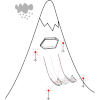AvaRange
The Problem

The destructive potential of gravitational mass flows, such as snow avalanches, has a large socio-economic impact in mountainous regions. Our current understanding of flow dynamics on a particle level is mostly based on laboratory experiments and computer simulations. Measurement techniques of snow avalanches usually involve either non-invasive externally observable characteristics or invasive flow-obstacle interactions. An appropriate non-invasive in-flow measurement method, that allows to assess the influence of snow and particle properties, such as temperature, density, size, or shape, on processes like segregation, phase separation, and eventually flow mobility, is missing.
Our Technology
The project AvaRange aims at bridging this gap by making use of technical advances in the fields of inertial sensors and wireless ranging to examine the internal flow behavior of avalanches. Embedded systems with communication and sensing capabilities will be used for real-time measurements. Equipped with robust housings and placed in release areas, the sensors will be able to move with the avalanche. Inertial navigation provides information on the local motion of each sensor and radio ranging methods allow multiple sensor systems to communicate and track their distances over time. Together, these approaches are the basis to develop novel in-flow measurement methods for gravitational mass flows, which allow to track particle motion within an avalanche. Experimental feasibility studies and examinations of existing motion analysis algorithms show that state of the art solutions are not yet able to do so. The AvaRange system will be the first systematic approach to collect in-flow data with high precision in real-world avalanche scenarios.
Our Goal
Overall, AvaRange has the potential for major breakthroughs in the understanding of internal dynamic processes and flow mobility of avalanches, which determine flow, stopping, and run-out behavior as well as impact pressures. Detailed information on particle trajectories will contribute to the development of avalanche flow models, which are an integral part of avalanche simulations and hazard mapping applications. The harsh experimental environments demand inexpensive, durable, yet highly accurate sensor combinations with robust radio transmission in snow. These sensors will also be of interest for all kinds of different gravitational mass flows beyond the scope of the project. The understanding of particle transport and the respective flow trajectories in avalanches is highly relevant, e.g., for skier burial location prediction or transport of debris material and their possible impact location. An increased understanding of granulation and segregation processes will further be beneficial to design of avalanche safety equipment.
Our Team
To adequately address the described fundamental research challenges, a highly specialized, interdisciplinary, and transnational consortium has been formed including Prof. F. Dressler (DE), who is an expert on distributed embedded systems, ultra-low power wireless communication, and tracking applications, Prof. J. Gerstmayr (AT) with emphasis on robotics and multi body dynamics, and Dr. J.-T. Fischer (AT) for the experimental and computational avalanche dynamics aspects. The team is supported by internationally leading experts in particle flow and avalanche dynamics.
